初一下学期英语教案
- 格式:docx
- 大小:11.80 KB
- 文档页数:7
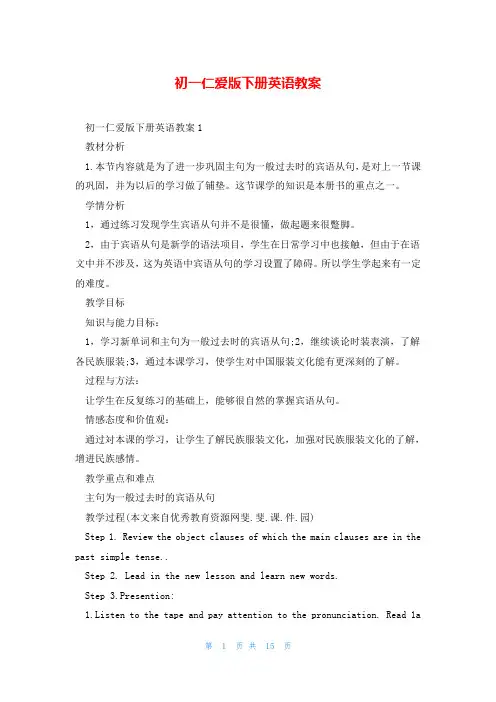
初一仁爱版下册英语教案初一仁爱版下册英语教案1教材分析1.本节内容就是为了进一步巩固主句为一般过去时的宾语从句,是对上一节课的巩固,并为以后的学习做了铺垫。
这节课学的知识是本册书的重点之一。
学情分析1,通过练习发现学生宾语从句并不是很懂,做起题来很蹩脚。
2,由于宾语从句是新学的语法项目,学生在日常学习中也接触,但由于在语文中并不涉及,这为英语中宾语从句的学习设置了障碍。
所以学生学起来有一定的难度。
教学目标知识与能力目标:1,学习新单词和主句为一般过去时的宾语从句;2,继续谈论时装表演,了解各民族服装;3,通过本课学习,使学生对中国服装文化能有更深刻的了解。
过程与方法:让学生在反复练习的基础上,能够很自然的掌握宾语从句。
情感态度和价值观:通过対本课的学习,让学生了解民族服装文化,加强对民族服装文化的了解,增进民族感情。
教学重点和难点主句为一般过去时的宾语从句教学过程(本文来自优秀教育资源网斐.斐.课.件.园)Step 1. Review the object clauses of which the main clauses are in the past simple tense..Step 2. Lead in the new lesson and learn new words.Step 3.Presention:1.Listen to the tape and pay attention to the pronunciation. Read 1ain different ways to learn it2. Let the students answer some questi. And then fill in blanks according to 1a.Step 4. PracticeLead into Part 2and practice the object clauses of which the main clauses are in the past simple tense.Step 5.Colidation :Step 6.Homework:教学环节一,复习二,导入三,呈现四,练习五,巩固六,作业复习宾语从句,然后利用宾语从句引入新课,并展示图片,学习生词,进而学习少数民族服装,处理第三部分。

初一英语教案模板范文5篇初一英语教案模板范文5篇写教案不能千篇一律,要发挥每一个老师的聪明才智和创造力,老师的教案要结合本地区的特点,因材施教。
老师要根据学生特性进行教学研究、教学交流和教学探讨。
以下是带来的初一英语教案模板范文内容,感谢您的阅读,希望能帮助到您!初一英语教案模板范文1一、Teaching Demands and Aims(教学目标)二、Teaching important and difficult point (教学重点)1、words2、sentences3、grammars三、Teaching Aids (教具)四、Teaching procedures(教学过程) Greeting(问候) warm up(热身) Review(复习) NewLeon(新课) Step One: Step Two: Step Three: Follow up(叮咛)五、Homework(作业布置)作业的布置一、书面作业1、每节课后教师可适当选择课后习题(书本或课外参考书)及字母作业。
2、低年纪的孩子适合听磁带读课文、画图、连线、写字母等简单作业;每学期两次测试:半期考和期末考试。
3、高年纪的孩子要求抄单词、背单词、背课文等书面作业;每节课前可做适当的听写练习;每个月可做适当的单元测试;期间两次大考:半期考和期末考。
二、磁带作业1、适时布置(条件允许可每周一次):将本周学习的内容录进磁带,下周上交。
2、录制要求:首先让学生和老师打招呼,接着报朗诵单元,然后录作业内容,最后与老师说再见。
(如:Hello! Amanda.I am Gogo.This is Unit 11……… Goodbye! Amanda!)3、听音修正:(1)书面记录:边听边把学生的错音登记在学生手册上。
(2)修正过程:A:打招呼,先表扬肯定,后提出错误,注意错音的跟读B:说悄悄话,增进师生感情交流C:提出问题。
D:结束Say:“ Good bye! ”三、电话教学1、时间安排:每月两次的电话教学,每生教学时间不超过8分钟。

七年级英语外研版下册教案通用5篇七年级英语外研版下册教案通用5篇英语教师研制一份教案,是为了加强课堂教学的目的性和计划性。
下面是小编为你准备的七年级英语外研版下册教案,快来借鉴一下并自己写一篇与我们分享吧!七年级英语外研版下册教案篇1一、指导思想在本学期的英语教学中,坚持《英语课程标准》中以下教学理念,面向全体学生,关注每个学生的情感,激发他们学习英语的兴趣,帮助他们建立学习的成就感和自信心,让学生在老师的指导下通过感知、体验、实践、参与和合作等方式,实现任务的目标,感受成功;注重过程评价,促进学生发展,建立能激励学生学习兴趣和自主学习能力发展的评价体系。
总之,让学生在使用英语中学习英语,让学生成为使用者而不仅仅是学习者。
让英语成为学生学习生活中最实用的工具而非累赘,让他们在使用和学习英语的过程中,体味到轻松和成功的快乐,而不是无尽的担忧和恐惧。
二、教材分析这套教材采用任务型语言教学模式,融汇话题、交际功能和语言结构,形成了一套循序渐进的生活化的学习程序。
与原教材相比还增加了文化背景和学习策略等部分,并增加了任务型学习成份和语篇的输入。
本书每个模块都列出明确的语言目标、主要的功能项目与语法结构、需要掌握的基本词汇,并分为三个单元。
Unit1部分是基本对话内容,Unit2部分是短文,主要是阅读训练。
Unit3是扩展和综合的语言运用。
三、学生基本情况分析我所任教的是七年级1、2班英语,只有少部分学生的英语基础较好,取得了一定的成绩,大多数学生不能明确学习英语的目的,没有真正认识到学习英语的目的在于交流;没有养成良好的.学习习惯,不能做好课前预习课后复习,不善于发现和总结语言规律,不注意知识的巩固和积累。
四、具体措施1、每天背诵课文中的重点对话。
目的:要求学生背诵并默写英语句子,培养学生良好的英语语感。
2、每天听写本节课中需要用到的重点生词,常用句子或习语。
利用“互测及教师抽查”及时检查,保证效果并坚持下去。

2024年七年级英语教学设计2024年七年级英语教学设计1一、指导思想认真学习新课程教学大纲和全册教材。
明确教学任务和教材体系,把握重点单元和章节,在此基础上制订全学期授课计划。
掌握教材的教育因素和知识点,根据教材和学生的实际,确定重点难点,明确德育渗透,双基训练、智能培养等各项教学目标,精心设计教学程序,选定教学方法。
端正教育思想,全面贯彻教育方针,努力探索教学规律,遵循教学原则,积极推进素质教育.二、教学目标在新课程理论的指导下,我将以学校教育处和英语教研组工作计划为指导,积极听课,加强课堂教学,高效地完成本学期英语教学目标。
并积极参加教科研活动,加强理论学习,努力使自身的教学水平、业务能力有更大的提高。
同时,通过传授与学生生活密切联系的英语知识,训练英语的听说能力,培养学生学习英语的兴趣和运用英语的能力,最终使学生从“学会英语”向“会用英语”发展。
三、学情分析本学期我担任七年级(5)、(6)班的英语教学工作,七(5)班共有学生57人,男生33个,女生24个。
七(6)班有学生57人,男生32个,女生25个。
在这些学生中,两个班均是男生人数大于女生,学生英语基础知识和听说能力水平不一,大部分学生虽然在小学接触过英语,但应用能力十分薄弱,特别是听力题,大部分学生听起来都很吃力。
面对学生掌握英语的程度不一,我将采用高效课堂模式,分层教学与整体教学相结合的方式完成教学任务,努力提高他们的英语水平。
另外,两班学生在情感态度、学习策略和文化意识方面还存在诸多需要进一步解决的问题。
例如:个别学生不明确学习英语的目的;有些同学对学好英语缺乏自信,不敢用英语表达;缺乏小组合作意识;一些学生没养成良好的学习习惯,不能做好课前预习课后复习,学习没有计划性和策略性;不善于发现和总结语言规律,不注意知识的巩固和积累。
所以,现阶段最重要的是激发学生学习英语的兴趣和积极性,帮助他们增强信心,克服困难。
除了从思想上给予引导之外,更重要的是在教学上,有针对性、目的性、有系统、有计划地上好课。

Unit 6 Our Local Area 《Topic 1 Is there a clock on your desk?》教案教案由京翰教育一对一家教辅导()整理Section ASection A needs 1~2 periods. Section A 需用1~2课时。
The main activities are 1a, 2a and 3. 本课重点活动是1a,2a和3。
Ⅰ. Aims and demands目标要求1. (1)Learn the words of rooms in homes:bedroom, kitchen, dining room, living room, bathroom(2)Learn other new words and phrases:garden, second, floor, upstairs, come in, house, grandfather, door2. (1)Learn some prepositions of position:in, on, next to, in front of, behind(2)Learn the structure of“T here be”.Oh, there are so many books on the shelves.Is there a computer in your study? Yes, there is.Are there any books in the study? Yes, there are.Ⅱ. Teaching aids 教具录音机/挂图/单词卡片Ⅲ. Five-finger Teaching Plan 五指教学方案Step 1 Review 第一步复习(时间:5分钟)复习现在进行时和一般现在时,引出1a中的新词汇。
(方案一)(老师在黑板上画一幅简笔画,让学生看图回答问题。
)T: Boys and girls. What’s Nancy doing?Ss: She is reading.T: Where is she reading now, do you know?Ss: In the study.T: Yes. She is reading in the study.(We usually read in the study.教师边说边在黑板的左上方并排写出“read, in the study”,教师继续问学生Then do you want to know where I sleep/cook/eat/watch TV…?引导学生向教师发问。
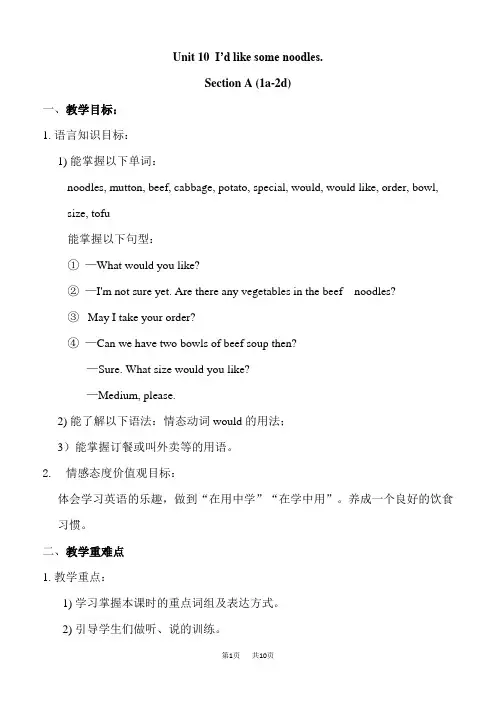
Unit 10 I’d like some noodles.Section A (1a-2d)一、教学目标:1. 语言知识目标:1) 能掌握以下单词:noodles, mutton, beef, cabbage, potato, special, would, would like, order, bowl, size, tofu能掌握以下句型:①—What would you like?②—I'm not sure yet. Are there any vegetables in the beef noodles?③ May I take your order?④—Can we have two bowls of beef soup then?—Sure. What size would you like?—Medium, please.2) 能了解以下语法:情态动词would的用法;3)能掌握订餐或叫外卖等的用语。
2. 情感态度价值观目标:体会学习英语的乐趣,做到“在用中学”“在学中用”。
养成一个良好的饮食习惯。
二、教学重难点1. 教学重点:1) 学习掌握本课时的重点词组及表达方式。
2) 引导学生们做听、说的训练。
2. 教学难点:通过role-play的方式掌握如何订餐等用语。
三、教学过程Ⅰ. Warming-up and lead in1. Watch a video program about food and vegetables.2. Ask and answer: What's your favorite food/drink/vegetables?Ⅱ. Presentation1. (show some pictures of food on the big screen)Present some new words and expressions to the Ss.2. Ss learn the new words and expressions by themselves and try to remember them.3. Work on 1a:Read the words on the left and look at the pictures on the right.the letters of the food on the . Then check the answers.Ⅲ. Game (Guess the food.)(Show some pictures of food on the big screen)Let Ss guess what food it is.Ss try to guess the food and learn the words.Ⅳ. ListeningT: In the following conversation, one man is ordering some food. Now, let’s listen to the tape, find out the right noodles the person orders.Play the recording for the Ss to listen and check the answers.Ⅴ. Pair work1.Present the conversation in 1b on the big screen and ask Ss to practice it.2. Make their own conversations using the noodles in the picture.3. Let some pairs act out their conversations.Ⅵ. Listening1. Work on 2a;T: Now, look at the pictures on the right, listen to the conversations and check the names of the foods you hear.(Play the recording for the first time, students listen carefully.Then, listen to the recording again, and check the names of the foods.Check the answers. )2. Work on 2b:(Play the recording for the Ss to listen and complete the sentences.)Play the recording twice. The first time Ss just listen. And the second time, Ss listen anddown the words.(If necessary, use the pause button to help Ss)3. Check the answers.Ⅶ. Pair work1. Ask and answer questions with your partner. Use the information in 2a.2. Show the conversations of 2a on the big screen to the Ss.3. Make a model for the Ss.T: What kind of noodles would you like?S1: I'd like beef noodles, please.…3. Ss work in pairs and practice the conversations.Ⅷ. Role-play1. Ask Ss to read the conversation in 2d and find the answer to the questions:What would they like?(They would like one large bowl of beef soup, one gongbao chicken, and one mapo tofu with rice.)2. Check the answers with the Ss.3. Ss work with their partners and role-play the conversation.VIII. Language pointsIX. ExercisesX . Homework1. Review the words and expressions in period.2. Role-play the conversation in 2d.3. Make a short conversation to order some noodles you like in a restaurant.Section A (Grammar Focus-3c)一、教学目标:1. 语言知识目标:1) 继续练习运用如何订餐或叫外卖等的用语。
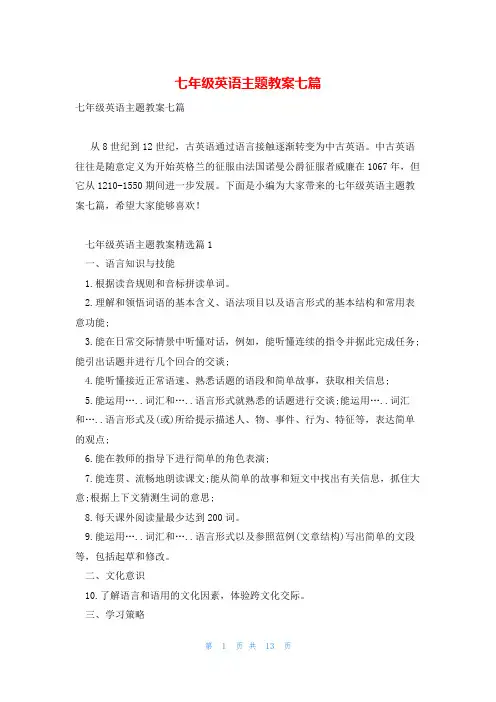
七年级英语主题教案七篇七年级英语主题教案七篇从8世纪到12世纪,古英语通过语言接触逐渐转变为中古英语。
中古英语往往是随意定义为开始英格兰的征服由法国诺曼公爵征服者威廉在1067年,但它从1210-1550期间进一步发展。
下面是小编为大家带来的七年级英语主题教案七篇,希望大家能够喜欢!七年级英语主题教案精选篇1一、语言知识与技能1.根据读音规则和音标拼读单词。
2.理解和领悟词语的基本含义、语法项目以及语言形式的基本结构和常用表意功能;3.能在日常交际情景中听懂对话,例如,能听懂连续的指令并据此完成任务;能引出话题并进行几个回合的交谈;4.能听懂接近正常语速、熟悉话题的语段和简单故事,获取相关信息;5.能运用…..词汇和…..语言形式就熟悉的话题进行交谈;能运用…..词汇和…..语言形式及(或)所给提示描述人、物、事件、行为、特征等,表达简单的观点;6.能在教师的指导下进行简单的角色表演;7.能连贯、流畅地朗读课文;能从简单的故事和短文中找出有关信息,抓住大意;根据上下文猜测生词的意思;8.每天课外阅读量最少达到200词。
9.能运用…..词汇和…..语言形式以及参照范例(文章结构)写出简单的文段等,包括起草和修改。
二、文化意识10.了解语言和语用的文化因素,体验跨文化交际。
三、学习策略11-(1)利用读音规则和音标拼读词汇,利用上下文、非语言信息等理解词义,联想学习和记忆词汇,构词法等。
11-(2)利用情境等理解语法结构和表意功能,发现语言规律并举一反三。
11-(3)复习、整理归纳所学内容。
11-(4)利用预测、语调、重音、问题等来获取听力信息。
11-(5)在课内外活动中借助体态语用英语交流。
11-(6)利用预测、跳读、寻读、细节读等来获取文章信息。
11-(7)仿写短文,准备素材、起草短文并修改。
11-(8)明确目标,制定计划,11-(9)了解并跨文化交际(恰当使用)。
四、情感态度12.乐于参与英语活动,敢于用英语表达,积极与他人合作,体验自己的学习效果。
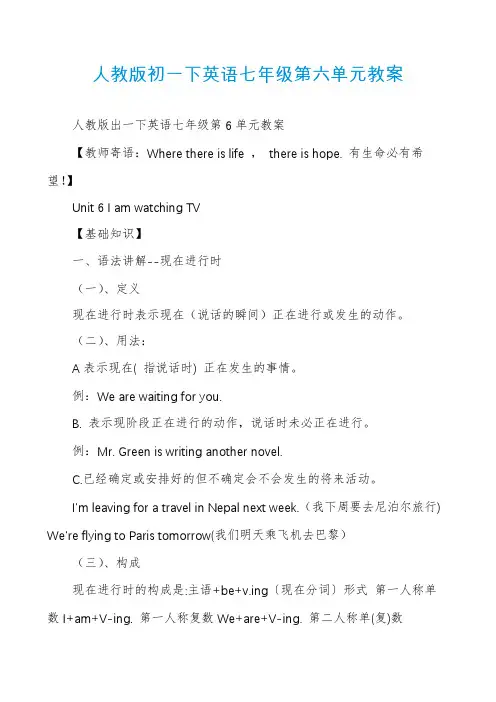
人教版初一下英语七年级第六单元教案人教版出一下英语七年级第6单元教案【教师寄语:Where there is life ,there is hope. 有生命必有希望!】Unit 6 I am watching TV【基础知识】一、语法讲解--现在进行时(一)、定义现在进行时表示现在(说话的瞬间)正在进行或发生的动作。
(二)、用法:A表示现在( 指说话时) 正在发生的事情。
例:We are waiting for you.B. 表示现阶段正在进行的动作,说话时未必正在进行。
例:Mr. Green is writing another novel.C.已经确定或安排好的但不确定会不会发生的将来活动。
I'm leaving for a travel in Nepal next week.(我下周要去尼泊尔旅行) We're flying to Paris tomorrow(我们明天乘飞机去巴黎)(三)、构成现在进行时的构成是:主语+be+v.ing〔现在分词〕形式第一人称单数I+am+V-ing. 第一人称复数We+are+V-ing. 第二人称单(复)数You+are+V-ing. 第三人称单数He(She,It)+is+V-ing. 第三人称复数They+are+V-ing.(四)、句型变化(1)肯定式:be+v-ing She is singing in the next room. (2)否定式:be+not+v-ing The students aren’t cleaning the room. (3)一般问句:be动词提前。
肯定答语Yes,主语+be; 否定答语No,主语+be not。
Are you playing the computer game? Yes, I am. No, I am not. (4)特殊问句:对谓语动词进行提问的:What+be +主语+doing+其他?What is the old man doing under the tree? 对其他成份进行提问的,疑问词+一般疑问句?人教版出一下英语七年级第6单元教案Where is the boy swimming? Who is she waiting for?【及时训练】1、按要求改写句子The boy is playing basketball.否定句:____________________________ 一般疑问句:_________________________肯定回答:__________________________否定回答:__________________________ 对“The boy”提问:__________________________2、把对话补充完整。
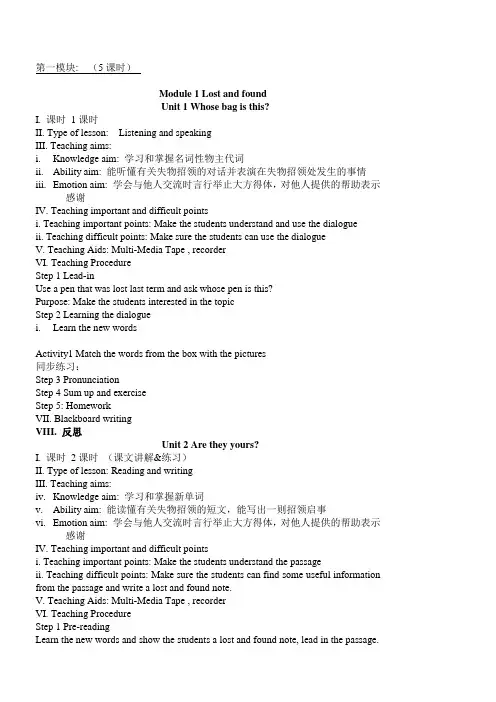
第一模块: (5课时)Module 1 Lost and foundUnit 1 Whose bag is this?I. 课时1课时II. Type of lesson: Listening and speakingIII. Teaching aims:i.Knowledge aim: 学习和掌握名词性物主代词ii.Ability aim: 能听懂有关失物招领的对话并表演在失物招领处发生的事情iii.Emotion aim: 学会与他人交流时言行举止大方得体,对他人提供的帮助表示感谢IV. Teaching important and difficult pointsi. Teaching important points: Make the students understand and use the dialogueii. Teaching difficult points: Make sure the students can use the dialogueV. Teaching Aids: Multi-Media Tape , recorderVI. Teaching ProcedureStep 1 Lead-inUse a pen that was lost last term and ask whose pen is this?Purpose: Make the students interested in the topicStep 2 Learning the dialoguei.Learn the new wordsActivity1 Match the words from the box with the pictures同步练习:Step 3 PronunciationStep 4 Sum up and exerciseStep 5: HomeworkVII. Blackboard writingVIII. 反思Unit 2 Are they yours?I. 课时2课时(课文讲解&练习)II. Type of lesson: Reading and writingIII. Teaching aims:iv.Knowledge aim: 学习和掌握新单词v.Ability aim: 能读懂有关失物招领的短文,能写出一则招领启事vi.Emotion aim: 学会与他人交流时言行举止大方得体,对他人提供的帮助表示感谢IV. Teaching important and difficult pointsi. Teaching important points: Make the students understand the passageii. Teaching difficult points: Make sure the students can find some useful information from the passage and write a lost and found note.V. Teaching Aids: Multi-Media Tape , recorderVI. Teaching ProcedureStep 1 Pre-readingLearn the new words and show the students a lost and found note, lead in the passage.Step 2 While-readingActivity 1: Listen and read the passage.Activity 2: Read the passage and answer the questions.Activity3: Translate and explain the language pointsActivity 4: Complete the passage with the correct form of the words and expressions from the box. (Activity3 on P5)Step 3 Post-readingWriting (Activity 4 on P5)Step 4 Sum up and exerciseStep 5: HomeworkVII. Blackboard writingVIII. 反思Unit 3 Language in useI. 课时2课时(课本练习&练习册)II. Type of lesson: GrammarIII. Teaching aims:vii.Knowledge aim: 名词性物主代词和形容词性物主代词的用法viii.Ability aim: 能利用名词性物主代词和形容词性物主代词解决一些问题ix.Emotion aim: 学会与他人交流时言行举止大方得体,对他人提供的帮助表示感谢IV. Teaching important and difficult pointsi. Teaching important points: Make the students solve some questionsii. Teaching difficult points: Make sure the students do the exercisesV. Teaching Aids: Multi-Media Tape , recorderVI. Teaching ProcedureStep 1: Activity 1: Work in pairs. Ask and answer questions.The teacher prepare some school things, ask every pair to choose a school thing, show the students a model, like this:--Whose bag is this? Is it yours?--No, it’s not mine. It’s his.Give the students two minutes to make the dialogue, then present in the class. Activity 2: Complete the sentences with the correct form of the words from the box. Give the students three minutes to finish it themselves, then check the answers together.Step 3: Match the words from Box A with the words from Box B.This activity is very easy, so the students can do it together.Step 4: Around the world---The Internet lost and foundAsk the students read by themselves, then translate one by one, the teacher explain the language points.Step 5: Activity 4: Work in pairs.The teacher prepares some things such as camera, crayons, football, gloves, mobile phone, wallet, watch and so on.Student A: Think of three or four things he/she has lost or he/she can choose from the box. Describe them.Student B: Think of five or six things you have in your lost and found office or you can choose from the box. Describe them.Then ask and answer questions.Student A: Ask Student B if they’ve got the things you have lost. Answer questions about details.Student B: Answer questions about the things Student A has lost. Ask questions about details.Give the students five minutes to prepare, then act out in the class.Step 6: HomeworkVII. Blackboard writingUnit 3 Language in useVIII. 反思第二模块(5课时)Module 2 What can you do?Teaching aims:1. Knowledge aim: 学习和掌握情态动词“can”.2. Ability aim: 能正确使用情态动词“can”表示能力的肯定、否定与疑问形式。
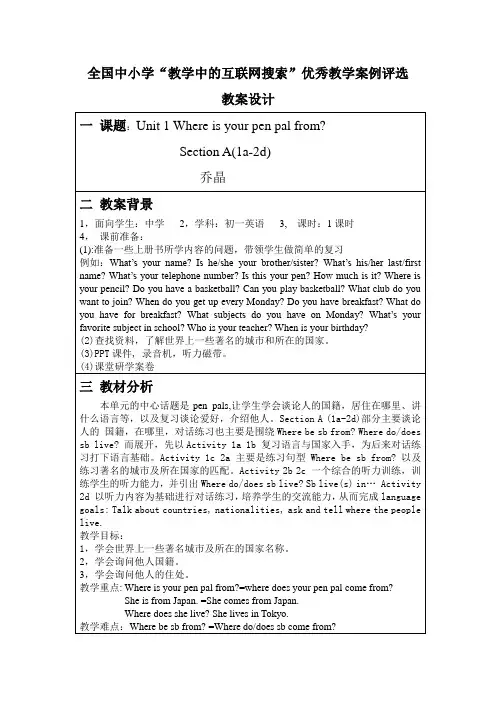
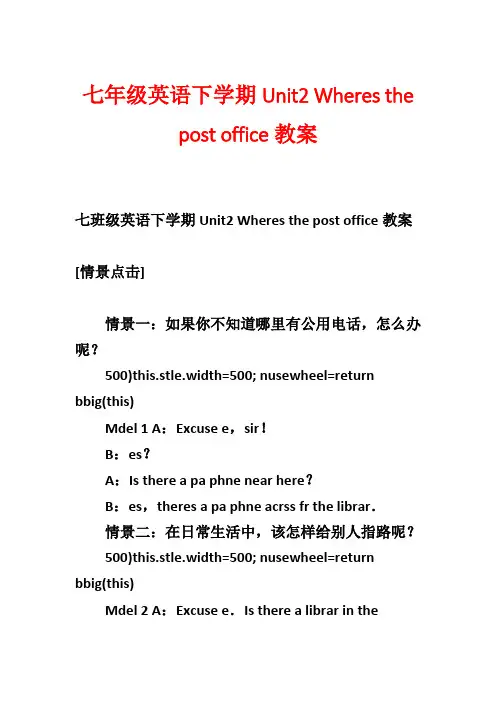
七年级英语下学期Unit2 Wheres thepost office教案七班级英语下学期Unit2 Wheres the post office教案[情景点击]情景一:如果你不知道哪里有公用电话,怎么办呢?500)this.stle.width=500; nusewheel=returnbbig(this)Mdel 1 A:Excuse e,sir!B:es?A:Is there a pa phne near here?B:es,theres a pa phne acrss fr the librar.情景二:在日常生活中,该怎样给别人指路呢?500)this.stle.width=500; nusewheel=returnbbig(this)Mdel 2 A:Excuse e.Is there a librar in theneighbrhd?B:es,there is.G straight and turn left.Its between the superaret and the vide arcade.A:Than u ver uch.B:u are welce.情景三:根据图示,介绍从第三中学去少年宫的路线。
500)this.stle.width=500; nusewheel=returnbbig(this)Mdel 3 M schl is N.3 Middle Schl.If u want t g t the Childrens Palace,Id lie t shw u the wa.Please g straight and tae the third turning n the right.Then g dwn and ull find the Childrens Palace.Its acrss fr the bus statin.u shuld tae a N.4 bus.It will tae u right there.[课标呈现]500)this.stle.width=500; nusewheel=returnbbig(this)。
Unit 4 Don’t eat in class.Section A 1a-2c【课型】听说课学习目标1.能熟练掌握本课重点词汇:rule, arrive ,hall, listen, sorry, outside, fight ,wear。
能初步口头掌握祈使句Don’t run in the hallways.2.能基本听懂含有本课重点词汇和目标语言的听力材料。
初步了解听前预测的技巧,并在听的过程中做到有目的地获取有效信息。
3.能理解遵守规则是每个学生的义务,并掌握Don’t eat in the classroom./We can’t eat in the classroom. Don’t listen to music in class./We can’t listen to music in class.并能运用目标语言谈论校规。
学习过程【自主学习】请在课前会拼读下面的单词,并熟记。
rule, arrive, hall ,listen ,sorry ,outside, fight, wear【新课导入】Step 1:Free talkT: How to be a good student?What can we do at school or in the classroom?What can’t we do?...S: We can’t...S: We can...【新知呈现】Step 2:Presentation1.根据图片提示,学习本课新词汇和句型。
Don’t eat in the classroom.Don’t arrive late for class.Don’t run in the hallways.Don’t play sports in the classroom.Don’t fight.2.看1a中的图片,将数字写到图中学生旁边。
【新知学习】Step 3: Listening 1bBefore listeningWhere are the school rules? 看课本图片中方框里的校规。
沪教牛津版七年级下册初中英语全册教案(教学设计)Unit 1 People around us 教案课题:Unit 1 --- People around us (阅读课)课时:第 1 课时,共4课时课型:new words教学目标:1.To know the meaning of the new words and the students can use the words to make sentences.2.To train the students’ ability o f cooperation.教学重点: The pronunciation and the usages of the new words: cheerful , hard-working , patient, person, smart, forget, smell , strict, encourage, remain , support successful, remember.教学难点: The usages of the new words: forget , remember , patient , strict, remain , strict.教学准备: e some pictures and games and PPT .2.a recorder .教学步骤:Step 1 Warming up. Freely talk:who do you like best around you ?show some pictures of teacher,father ,mother,friend, on the PPT to talk about them.Step 2 New words.1.Read the new words after the teacher or the tape.2.Group work to remember the new words3.Help the students when they have trouble in reading the new wordsStep 3 Key words learning.1.Show the PPT of the meaning of the key words for them to finish Part A1.2. Let Ss make more sentences with the new words .Step 4 Have a competitioncheck the words and give them marks for the groupsstep5 ReadingBefore reading : 1.Ask Ss to look at the pictures and the titles of the three articles on page 3.2.Check their answers.While reading : 1.Read the article quickly, and then finish Part D1.2. Check their answers.Post reading: 1.Ask Ss to finish Part C1 and C2.2. Check their answers.Step 6 Reciting the article1.Play the tape for them to listen and repeat.2.Show PPT for them to retell the article.ExercisesTo consulate the usages of the new wordsstep 7 SummaryGive them a piece of paper to write the words.Step 8 Homework1.Dictation2.correct the mistakesStep9 The blackboard designUnit 1 People around us1. be cheerful快乐2.as well 也3.take care of 照顾4.tell jokes 讲笑话5.make sb laugh 使某人发笑6.be good at 擅长于…7.be strict in sth 对某事严格要求be strict with sb对某人严格要求课题:Unit 1 People around us (听说课)课时:第2课时,共 4 课时课型:Listening & Speaking教学目标:1.Learn how to use the new words or phrases to describe a person2. improve their listening and speaking skills教学重点: To catch the missing words when listening教学难点: Learn to take note quickly when listening教学准备: Group work. Self—study教学步骤:Step 1: Prepare for the listening and speakingReview some words and phrases which can be used to describe a person Step 2: Do the listening1.Play the listening materials , stop when necessary2.Check the answersStep3.SpeakingGive a sample dialogue to students and ask them to imitate itStep 4:Make notes about the listening.1.Tell them to find the key words.2.Write down the key words you get in the listening part.Step5 Speaking1.学习双元音/iə/、/eə/、/uə/1)Read after the teacher or the tape.2)Read by themselves.2.Listen to the tape and finish A1 then check their answers.3.Learn A2. Ask Ss to read these sentences. Pay attention to the letters in red.4.Speaking upWork in groups to discuss the people they like .S1: Who do you like?S2: I like …S1: What does/did he/she look like?…Step6:Sum upStep7HomeworkStep8 The blackboard designUnit 1 People around us1.描写人的外貌的词2. 双元音/iə/、/eə/、/uə/课题:Unit 1 People around us(语法及运用课)课时:第3时,共 4 课时课型:Grammar教学目标:1.to grasp the usage of the definite word the and the preposition with2. to raise the students’ ability to sum up some language rules教学重点: Know when should use the in front of a noun and when we should not use it and the usage of the with phrases to describe a person教学难点: When we should not use the in front of a noun.教学准备:PPT, Blackboard教学步骤:Step1:Free talkTalk about the noun with an, a and the .Step2: WritingBefore writing: Give Ss the title of the article to talk about.1.Who are you going to write about?2.Think about the following ideas.1)a family member2)a good friend3)a teacher or a great personWhile writing:1.Write a short article about this person.Show some PPT to help them to write the article.2.介绍一些描述人常用的词汇.3. Ask Ss to re ad “My dad”as an example.Step3:More practiceAsk Ss to re ad the article about Mother’s Day quickly.Then answer the questions.1.When is Mother’s Day?2.What do people like to do this day?3.What do the author advise people to do on this day?Step4 Study skills1.Learn line graphs and bar charts to show the change in numbers.2.Fill in the blanks.3.Check their answers.Step 4:Culture corner1.Introduce middle names for Ss.2.Write some famous people’s middle names.Step5:Sum up1.Go over the rules of theStep6: HomeworkStep7 The blackboard design1.冠词“a\an”的用法。
七下Unit 3 Section B(2a-2c)ReadingCrossing the river to school教案一.教材分析本单元是人教版《Go for it 》七年级下册第三单元。
单元话题是“Transportation”。
通过单元学习,让学生学会“Talk about how to get to places”,理解并掌握“How long does it take? How do you get to school? How far is it? It takes sb. some time to do sth. It is adj. to do sth.”等句型的提问和回答。
让学生能谈论日常上学的经历,并且学会正确使用交通工具和数字1-30的英文表达。
同时培养学生的交通安全意识。
本课Section B (2a-2c) 是本单元的第四课时,是读写课。
目标是培养学生良好的阅读习惯,提高他们的阅读能力,增强他们对文章结构的整体感知能力,为接下来的写作教学奠定基础。
本课时的阅读材料讲述的是边远山区的孩子乘索道过河上学的感人故事,这个故事能吸引学生注意力和激发他们刻苦学习的动力。
二.教学设计理念《新课程标准》指出:语言学习要从语法讲解中和单词的死记硬背中解脱出来,要通过创设良好的语言环境和提供大量的语言实践机会,使学生通过自己的体验、感知、实践、参与和交流,形成语感;在教师的引导下,通过观察、发现和归纳等方式,掌握语言的规律,形成有效的学习策略,发展交流与合作的能力。
《英语新课程标准》明确规定:初中英语教学要侧重培养学生的阅读能力。
英语阅读教学的主要目的是教给学生正确的阅读方法、阅读技巧、培养学生的阅读能力,为继续学习英语和运用英语切实打好基础。
本节课以学生为主体,以课标为准绳,以多媒体为手段,以兴趣为中心,以合作为纽带,为学生创造一个轻松愉悦、积极向上的英语学习氛围,力争为每个学生都提供适合自己的学习和练习机会。
Unit 7 It’s raining.Section A (1a-2d)一、教学目标:1. 语言知识目标:1) 能掌握以下单词:rain, windy, cloudy, sunny, snow, weather, cook, bad, park,message, take a message, could, back, problem 能掌握以下句型:①—How's the weather in Beijing?—It's sunny.②—Can I take a message for him?—Yes. Could you just tell him to call me back?—Sure, no problem.2) 能用所学的知识描述天气情况。
3)描述正在发生的动作。
2. 情感态度价值观目标:教育学生善于观察天气,善于调整自己的情绪;了解世界各地的天气情况,增加世界观念。
知道大自然的力量是神奇而伟大的,我们应当好好学习,立志学好科学知识,为长大后探索神奇的大自然,打好基础。
二、教学重难点1. 教学重点:1) The vocabulary and useful expressions.2) —How’s the weather?—It's raining/ windy.3) —What are you doing?—I'm playing basketball.2. 教学难点:运用目标语言来对天气进行问答,并且会问答其他人正在进行的活动。
三、教学过程Ⅰ. Warming-up and Lead in1. Greet the Ss and check the homework.2. Watch a video program about the weather.Ⅱ. Presentation1. (Show some pictures of the weather)Let Ss look at the pictures and ask them how the weather is.Ss learn the new words and expressions with the help of the pictures.2. Look at the pictures in 1a. Then read the new words on the right. Ask the Ss tomatch the words with pictures.3. Check the answers.Ⅲ. Game (How's the weather?)1. (Showing some pictures on the big screen.) Ask Ss "How's the weather?"2. Ss guess and answer the question.Ⅳ. Listening1. Now let's look at the city names in the box in 1b. Please read after me.Ss read the cities after the teacher.2. Now, We’ll hear four conversations. Listen carefully, point out each city in thepicture as it comes upon the tape. Play the recording a second time. Ask Ss to write the name of the city in the picture of its weather.3. Check the answers.Ⅴ. Pair work1.Tell the Ss: If you are in one of the places in the picture above. Talk about theweather with your friends in another city on the phone.2. Make a model with a student like this:T: Hi! How's the weather in Beijing?S1: It's sunny.3. Ss work in pairs. Ask and answer about the weather in the cities.Ⅵ. Listening1. Work on 2a.Let's see what Joe's families are doing. Point to the 4 pictures.2. Ask Ss tell each person is doing in each picture. More attentions should be paidto the correct use of the Present Progressive Tense.3. Play the recording for the Ss to listen and number the pictures [1-4].4. Play the tape for Ss to check the answers.5. With the whole picture, get some Ss to tell the story of it.6. BrainstormingPlay the tape for another time. Then do a memory test.Ask Ss: What's Uncle Joe/Jeff/Mary/Aunt Sarah doing?What're Scott and Lucy doing?Is Jeff watching TV? etc.7. Let Ss match the names with the activities in 2b.Play the recording for the Ss to check the answers.Ⅶ. Pair work1. Look at the pictures and talk about the people in 2a with a partner.2. Ask a student the questions as a model:T: What's Uncle Joe doing?S1: He's playing basketball.3. Ss work in pairs. Ask and answer about the pictures.Ⅷ. Role-play1. Ask Ss to read the conversation and answer the questions:①What's Steve doing?②What's Rick's brother doing?Ss read the conversations and answer the questions. Then check the answers together.2. Let Ss role-play the conversation in pairs.IX. Language points.X. ExercisesHomework:一、总结有关天气的词汇。
胡屯镇中学初一英语下册教案(集备) 年级 初一 科目 英语 课题 M6U1Could you tell me how to get to the NationalStadium?课型 新授 节数 21 时间主备人使用人教学目 标 1、知识目标: Words :掌握单词。
Drills :问路、指路、对某一区域进行描述Grammar :能够正确运用方位介词2、能力目标: 听: 能够听懂指路的语句内容并搭配图片 说:能够问路、指路并给出具体方位 读:能够读懂对地图的描述;读懂对某一个地方的描述 写:能够通过书面表达给别人指路 3、情感目标: 培养学生克服困难,参加各种英语活动的情感。
乐于参加各种实践活动,乐于了解别国文化。
教 学 重、难点问路和指路的表达方式Asking for directions and giving directions. 难点:问路和指路的准确表达 ,方位介词和词组的正确运用。
Step1激情导入 1.Greeting.2.Warm-u p :What should you do when you want to a new place?Step2自主学习Review: Words and expressions Presentation of the vocabulary with sentences. Read through the new words and have the students follow and then repeat chorally and individually.Step3 合作学习A..Work in pairs. Look at the map .You ’re in Wangfujing Dajie.Ask for and give directions to other places. Excuse me, how do I get to the the National Stadium ? Go along the street…活动(一) 激情导入:(教师展示图片,学生根据图片快速说出单词)活动(二) 自主学习1. 布置学生预习词汇并按照音标朗读,小组解决自己不会拼读的词汇: 2. 结合新单词,学生小组讨论并展示句B. Say where the places in activity 1 are. Use the words in Activity 5. The supermarket is opposite the restaurant.C. Work in pairs. Draw a map of your neighbourhood. Now ask for and give directions to places on he map. Where ’s the market ? It ’s on … How do I get there ? Go along …Step4质疑释疑,精讲点拨1.问路的常用句型有:Where is the way to ...? How could I get to ...? Do you know where ... is ? Could you tell me the way to ...?2.指路的常用句型有:Go along … Turn right / left at the …crossing . It ’s next to … It ’s opposite … It ’s between … and … 等。
七年级下册英语教案人教版(优秀6篇)七年级英语下册教学计划篇一一、本学期的指导思想本人在本学期的英语教学中,坚持以下理念的应用:1、要面向全体学生,关注每个学生的情感,激发他们学习英语的兴趣,帮助他们建立学习的成就感和自信心,培养创新精神;2、整体设计目标,体现灵活开放。
3、突出学生主体,尊重个体差异;4、采用任务型的教学模式,让学生在老师的指导下通过感知、体验、实践、参与和合作等方式,实现任务的目标,感受成功;5、注重过程评价,促进学生发展,建立能激励学生学习兴趣和自主学习能力发展的评价体系。
二、教材分析本书每个单元都列出明确的语言目标、主要的功能项目与语法结构、需要掌握的基本词汇,并分为A和B两部分。
A部分是基础的语言内容,B部分是知识的扩展和综合的语言运用。
对于我们学生来说,由于小学基础不好,到初中以后学起来的确有些吃力,尤其是一千多个单词的记忆和简单的语法就吓退了不少学生学习英语的兴趣。
但我们必须知难而上,坚守教师职责,实实在在为英语教学成绩而努力。
三、教学目标对英语学习表现出积极性和初步的自信心。
能尝试使用适当的学习方法,克服学习中的困难。
常用的训练活动有以下几项:(1)Daily report:值日生介绍自己、家庭成员或朋友的情况,其它学生可互相提问题,询问个人职业。
(2)Play a guessing game:用问题“what does he do?”引入任务,让学生猜测多媒体课件中人物的职业,以此激发学生的学习兴趣,并训练学生的发散思维能力。
(3)Ask the way :创设问路情景,根据实际情况telling the way,eg. I want to go the hospital 完成对话活动。
通过训练把课内的语言学习与课外的语言活动结合起来,改变了过去老师一言堂的模式,变学生为主体,课堂主要是提供了一个学生获取知识的平台。
学生在活动中主动地获取知识。
四、具体实施方案1、加强词汇教学。
初一下学期英语教案【篇一:人教版七年级英语下册unit 1教案】unit 1 can you play the guitar?section a (1a-2d)一、教学目标:1. 语言知识目标:1) 能掌握以下单词:guitar, sing, swim, dance, chess, play chess, draw, speak, speak english, join, club能掌握以下句型:①—can you play the guitar? —yes, i can./ no, i cant.②—what can you do? —i can dance.③—what club do you want to join? —i want to join the chess club.2) 能了解以下语法:情态动词can的用法want to do sth.的用法2. 情感态度价值观目标:该部分内容贴近学生的生活,谈论的话题是能力。
通过互相询问或谈论自己或对方在某一方面的能力,可以培养学生的一种群体意识。
二、教学重难点1. 教学重点:1) 学习询问和谈论彼此的能力和特长;2) 掌握一些弹奏乐器的表达方式。
2. 教学难点:情态动词can的构成和使用。
三、教学过程Ⅰ. lead in1. 教师可携带一些易于演奏的乐器,也可带一些演奏乐器的图片,一边演示乐器,一边说: i can play the guitar.…等;再指着图片说:he/shecan play the violin.but i can’t play it.等;然后询问学生:can you play the guitar?….并引导学生进行简单的回答。
2. ss look at the picture in 1a. then read the words and phrases. let ss match theactivities with the people.then check the answers with the class together.Ⅱ. presentationⅢ. game (what can i do?)t: tell your partners what you can do. for example:i can play the guitar. i can sing and dance.ss work in groups. the let some ss talk to their classmates in front of the class. Ⅳ. listening1. t: now let’s listen to the tape, find out the right con versation, and number them1-3.(播放lb部分的录音让学生听,引导学生根据所听到的内容,选出对话的顺序,完成1b部分的教学任务。
)2. check the answers:(3, 2, 1 )Ⅴ. pair work1. ask the ss to practice the conversations in 1b with a partner. then make their own conversations.(引导学生展开pairwork活动,完成lc部分口语交际的教学任务,学会运用can询问和表达能力。
)Ⅵ. listening1. work on 2a;t: now, look at the pictures on p2, listen to the four conversations. just listen.(play the recording for the first time, students only listen carefully.)then, listen to the recording again, and circle the clubs you hear.check the answers with the class.2. work on 2b;引导学生根据对话内容用正确的单词填空,补全对话,再播放听力材料一遍。
让学生进行校对,练习听力和写作能力,完成2b部分的教学任务。
check the answers with the ss.Ⅶ. pair work1. look at 2b and talk about what the people can do and the clubs they want to join.老师可以和一名优秀的学生做一个对话的例子,让学生们明白如何去问答,例如:t: what club does lisa want to join?s1: she wants to join the chess club.t: can she play chess?s1: no, she cant.2. ss work in pairs to practice asking and answer about lisa,bob and mary.3. ask some pairs to act out their conversations.Ⅷ. role-play1. ask ss to look at the picture in 2d. then ss read the dialogue by themselves and tryto find out the answers to these questions.① what club does bob join?② what club does jane join?ss read the conversation by themselves and find the answersto the questions. then check the answers:① bob joins the soccer club.② jane joins the english and art club.2. explain something that ss cant understand.3. let ss read after the teacher or play the recording and let ss read after therecording.4. ss work in pairs to act out the conversation.5. ask some pairs come to the front of the classroom. they tryto act out the conversation. see which group is the best.homework:1. remember the new words and expressions after class.2. recite the conversation after class.3. write english names as many as possible in the exercises book.板书设计:section a (grammar focus-3c)一、教学目标:1. 语言知识目标:1) 继续练习运用情态动词can。
学会询问和谈论彼此的能力和特长。
能掌握以下句型:①—can you play the guitar? —yes, i can./ no, i cant.②—what can you do?—i can dance.③—what club do you want to join? —i want to join the chess club.该部分学习询问或谈论自己或对方在某一方面的能力和特长,可以培养学生的一种群体意识,促进同学们对自身的认识,为将来的自我发展奠定基础。
二、教学重难点1. 教学重点:1) 让学生重点总结、发现情态动词can的用法。
2) 通过一些与学生们实际生活相贴近的教学活动,来达到熟练运用的目的。
2. 教学难点:1) 情态动词can的用法;2) 在实际交际活动中运用can来询问与表达自己或他人的能力。
三、教学过程Ⅰ. warming- up and revision1. ask some ss about their abilities.t: hi, s1! what can you do?s1: i can sing and dance?t: can you play the guitar?s1: sorry, i cant. but i can play chess.t: what club do you want to join?s1: i want to join the chess club.2. role-play.let some pairs role play the conversation in 2c.Ⅱ. grammar focus.1. 阅读指导:2. 学生阅读grammar focus中的句子,然后做填空练习。
①你会游泳吗?______ you ______?②是的,我会。
/ 不,我不会。
yes, ____ _______. / no, i _______.… (其余试题见课件部分)3. 学生们完成填空试题后,可以打开课本检查答案,对错误的句子,单独进行强化记忆。
Ⅲ. try to find老师将情态动词的can的用法,以学案的方式呈现在大屏幕上,让学生自主学习,并发现其用法。
1. 可以看出,在can…?句型中,情态动词can没有________和_______ 的变化。
2. 用情态动词can来询问他人的能力可以归纳为以下句型:can + _______+ _________ + 其他?肯定回答:_________________否定回答: _________________what + can + _______ + ________ ?学生们合作学习讨论上面学案的答案,总结情态动词can的用法。
老师找部分学生对上述问题作答,并一起讨论总结情态动词can的用法。
Ⅳ. practice1. look at 3a. 告诉学生们用所给的词汇来造句子。
首先,用情态动词can及所给的【篇二:初一英语教学设计】初一英语教学设计unit5 topic 2 secton d一、教学设计理念英语是一门实践性很强的学科,必须通过大量的活动和练习,才能掌握和运用。